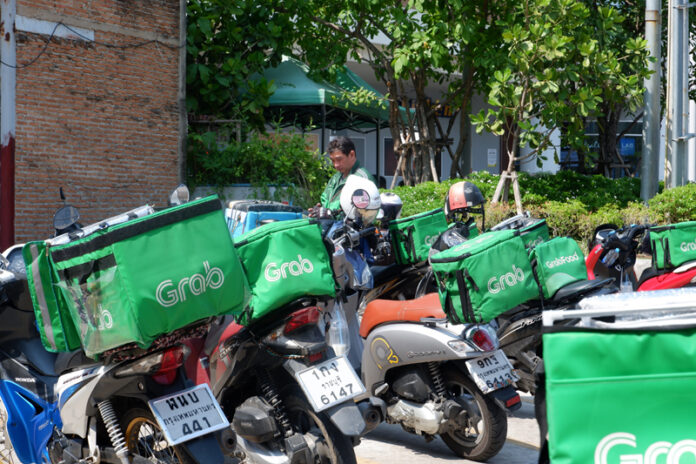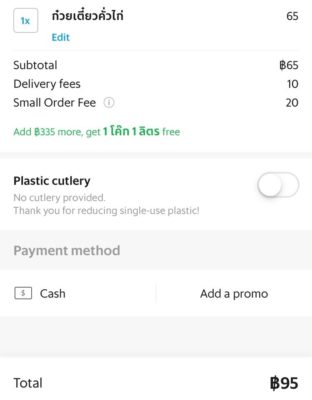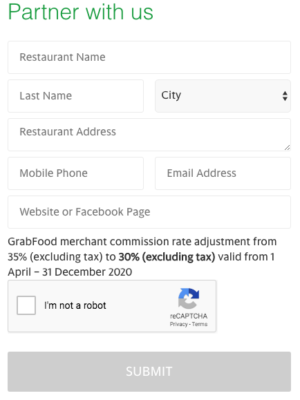
BANGKOK — For a month, Grab promised that an extra 10 baht charge per delivery would be given to the deliverymen during the coronavirus epidemic. It turned out that money never arrived.
Drivers also said they ended up making less during the pandemic than before, despite an increase in demand. And a growing complaint from restaurant owners accused Thailand’s largest ride hailing and delivery app of taking a cut as hefty as 35 percent from each order.
Following the uproar, Grab announced on Wednesday that they would decrease their commission rate to 30 percent, though that didn’t stop netizens from exploring other alternatives with relatively fairer offers for restaurant owners, drivers, and customers.
“It’s true Grab pushed up the commission fee with restaurants,” Chirayu Na Ranong, who owns three restaurants in Bangkok, said in an interview. “You used to be able to negotiate down to 20 to 25 percent, but now I hear the starting fee is 35 to 38 percent and non-negotiable.”
The company announced the commission cutback after several media agencies published stories revealing that the new 10-baht charge described by Grab as an extra fee for drivers was actually never paid to the drivers.
On March 24, Grab blamed the issue on “miscommunication.”
“[The 10-baht fee] was an increased delivery fee but due to a miscommunication that confused drivers, we will stop charging it as of March 24. This means Grab is no longer charging any extra delivery fees,” the company said.
The superfluous fee came with a March 4 update that charged restaurants 35 percent commission rather than the previous 30 percent, as well as a “Small Order Fee” of 20 baht from consumers for orders under 70 baht.
Grab deliverymen interviewed by Khaosod English also said they were making less money than they did before the COVID-19 crisis, compared to deliverymen for other apps, due to the unstable changes in the incentive system.

Tough Time for Restaurants
For restaurant operators, there’s little choice but to use Grab and other apps, no matter the commission deal they struck with them. Each restaurant pays a different commission rate with Grab, depending on individual negotiations, but chains are understood to score a better cut.
“In this situation, restaurants have no choice,” said Chirayu, who owns Fowlmouth, Crackhouse, and Chu restaurants.
Greg Lange, the owner and founder of Sunrise Tacos which opened back in 2007, said that most delivery apps charge restaurant owners a similar commission fee.
“No one is making money in the food delivery business. Grab would say they’re losing money because they have a lot of staff, drivers, and rebates,” he said. “We are trying to break even. It’s not to make money, but a lot of deliveries, like a hamster running around.”
Lange added, “Meanwhile restaurant owners are frustrated. Restaurant profit margins are around eight to 10 percent so you have to be a really good manager to make a profit if you’re also paying 30 to 35 percent commission.”
Grab isn’t the only player in town. Its rival Line Man charges customers a considerably high fee for deliveries, but does not charge restaurants any commission on their food orders, except venues that opt in its low-fee delivery programs.

“Lineman orders are increasing among some loyal customers who say they want to support us, even if it’s more expensive,” Chirayu said. “But that’s not the majority of people.”
Another serious competitor is Foodpanda, whose app is entirely in English, aiding expat customers. However, the app will only pay restaurants in 30 to 45 working days, although in emails to restaurants on Wednesday they promised to change to weekly payments in April.
Grab, on the other hand, sends restaurants their payment by the following day.
But Chirayu said he prefers direct orders to his establishments without going through any app because it’s the most profitable option for his business.
“If you have a restaurant you like, please contact them on the best way to get your food delivered,” said Chirayu, who personally handles daily orders at one of his restaurants. “At least you’ll get to talk to a human person and have them recommend what’s available, not just press buttons on a screen,” he said.
Related stories:
Food Delivery Drivers Brave Virus Anxieties While Feeding Bangkok















































